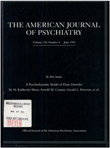High nocturnal body temperature in premenstrual syndrome and late luteal phase dysphoric disorder
Abstract
OBJECTIVE: Because women with late luteal phase dysphoric disorder (LLPDD) experience symptomatic affective states predictably, they can be studied to determine whether there are biological findings related solely to the clinically symptomatic state. The authors sought to answer the question, Does body temperature change with affective state? METHOD: The core body temperature and motor activity patterns of 10 women with premenstrual syndrome (PMS), six of whom also met criteria for LLPDD, and no other psychological or medical illness were compared to those of six women with chronic, noncyclic dysphoria and six asymptomatic comparison women at four phases of the menstrual cycle. RESULTS: The nocturnal temperatures of the women with PMS/LLPDD were significantly higher than those of the comparison subjects across the entire menstrual cycle, but there were no differences in nocturnal activity levels. The women with noncyclic dysphoria had a mean nocturnal temperature in the follicular phase as high as that of the women with PMS/LLPDD. The temperatures of all women were higher in the luteal phase than in the follicular phase. CONCLUSIONS: These findings suggest that in the future investigators should document menstrual cycle phase in all female subjects and, when studying body temperature, should carefully monitor symptomatic state in comparison subjects.
Access content
To read the fulltext, please use one of the options below to sign in or purchase access.- Personal login
- Institutional Login
- Sign in via OpenAthens
- Register for access
-
Please login/register if you wish to pair your device and check access availability.
Not a subscriber?
PsychiatryOnline subscription options offer access to the DSM-5 library, books, journals, CME, and patient resources. This all-in-one virtual library provides psychiatrists and mental health professionals with key resources for diagnosis, treatment, research, and professional development.
Need more help? PsychiatryOnline Customer Service may be reached by emailing [email protected] or by calling 800-368-5777 (in the U.S.) or 703-907-7322 (outside the U.S.).



